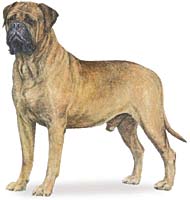INSTANT PROMOTION - LIMITED TIME OFFER - GET YOUR PUPPY COUPON TODAY
Hicksville: 516-938-7877
Lynbrook: 516-825-7877
Hicksville: 516-938-7877
Lynbrook: 516-825-7877
Currently we do not have any Bullmastiff Puppies available.
Please complete the form below to be notified when they are back in our stores.

Height: Females: 24 – 26 inches; Males: 25 – 27 inches. Weight: Females: 90 – 120 lbs.; Males: 110 – 130 lbs.
Colors: Shades of brindle, fawn or red. Slight white marking on the chest is permissible, although other white markings are undesirable. They have a black mask most often, and can be any shade of brindle, fawn, or red. Coat: Short, smooth and dense. Fur is hard and flat.
Temperament: Bullmastiffs are loyal, fearless, and will pursue if commanded. They are very loving and docile with friends and family. They are quiet, patient and alert. They can be territorial and protective, though, so training is necessary when they are pups. They are not for the fragile or timid owner. They are too powerful for children to control as well, and require a firm but loving command. They can be stubborn, but are not easily roused to anger. Some can be aggressive towards strange dogs, and are fearless when challenged. With Children: Yes. They are dependable with children. With Pets: If properly socialized the Bullmastiff will get along with other pets. They can be dominant to their own kind. Special Skills: Guard and watch dog, companion and family pet.
Watch-dog: Very High. Bred for this specific use, they can hide in the shadows silently until movement is needed. Guard-dog: Very High. They are excellent body guards, a natural guard-dog to family and home. Bullmastiffs will pursue vigorously but if trained, will not attack or maul the pursuant.
Care and Exercise: Minimal brushing of the Bullmastiffs coat is needed. A good rubdown with a rubber brush or massage glove will remove old dead hairs. Nails should be kept short. Diet and daily exercise are need to be balanced to prevent obesity. Bullmastiffs need moderate daily walks or a play session and lot of running space. Coat care is minimal. Bullmastiffs tend to drool and snore, and do not do well in hot weather. Training: Obedience training should begin at a young age. A Bullmastiff is sensitive to the tone of your voice. They will do best with fair, stable and a consistent approach to training. They are usually very obedient. Special Needs: Socialization, training, and protection from the heat. Learning Rate: High. Obedience – Very High. Bullmastiffs were chosen over regular Mastiffs in hunting poachers because of their obedient nature. Problem Solving – High.
Activity: Outdoors – High. They are active dogs when in their natural environment. Indoors – Low. Like the Bulldog, energy isn’t a huge priority of the Bullmastiff when its around family. Living Environment: A large fenced backyard or the country is preferred. An owner of a Bullmastiff must be a strong, easygoing, confident leader. They must be loving but firm. They may be too large for an apartment life, but adapts well to different living situations. The best owner for a Bullmastiff would be a family living in a house with a yard and fence. Bullmastiffs do not do well in hot weather.
Health Issues: Hip dysplasia, cancer, tumors, and gastric torsion or bloat (twisted stomach). Bloat is a health issue to most dogs, being the second largest killer of dogs other than cancer, but Bullmastiffs can be particularly susceptible to it because of their deep chests. Other health concerns include elbow dysplasia, eye problems, cardiac disease, hypothyroidism, kidney problems, and panosteitis (bone disease).
Life Span: 8 – 12 years, not usually more than 10. Litter Size: 5 – 8 puppies.
Country of Origin: Great Britain History: Developed in the late nineteenth century, the Bullmastiff was created by crossing the Mastiff with a Bulldog. The need for a good poacher-hunting dog was in store, and gamekeepers combined these two for speed and power. The Mastiff was powerful but not very fast, and the Bulldog was quicker, being smaller, but not large enough to overpower. Around this time, estate owners who owned game had such a terrible problem with poaching that the death penalty was on the head of anyone who tried. This gave way to poachers being a danger to the gamekeepers, for which the Bullmastiff was needed. Bullmastiffs were trained to wait silently in the dark until the command was given to attack. The Bullmastiff was known to easily take down poachers, holding them until the owner came. The dogs were trained not to maul the poacher but to take them down and hold them. This led to the dog’s title of “Gamekeeper’s Night Dogs”. Around the turn of the 20th century, poaching was not as much of a problem, but staged hunts were planned to keep the dog in practice. Volunteers ran out into the forest for a few minutes, then the Bullmastiff was released to track him down. The Bullmastiff would be found holding down the victim, but not attacking, and then his master would arrive. According to records, the dogs were always the winners. In 1924 Bullmastiffs were standardized and officially recognized in England, followed by the American Kennel Club in 1933. In England, the breed is considered best if about 50 percent Bulldog and 50 percent Mastiff, while Americans prefer the breed to be about 60 Mastiff and 40 percent Bulldog.
First Registered by the AKC: 1934 AKC Group: Working Class: Working Registries: AKC, ANKC, CKC, FCI (Group 2), KC (GB), UKC